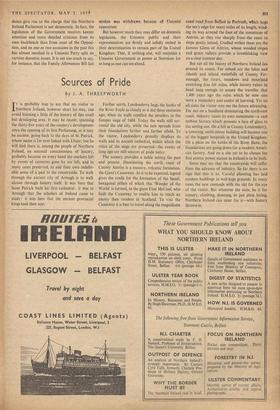Sources of Pride
By J. A. THREEPWORTH Iis probably true to say that no visitor to 'Northern Ireland, however short his stay, can avoid learning a little of the history of this small but developing area. It may be recent, spanning the thirty-five years of the country's development since the opening of its first Parliament, or it may be ancient, going back to the days of St. Patrick, whose name is for ever linked with Ulster; but he will find there is, among the people of Northern Ireland, an unusual consciousness of history, probably because on every hand the markers left by events of centuries gone by are left, and in many cases preserved, to add their own indefin- able sense of a past to the countryside. To walk through the ancient city of Armagh is to walk almost through history itself. It was here than Saint Patrick built his first cathedral: it was to Armagh that the scholars of Ireland came to study : it was here that the ancient provincial kings took their seat. Farther north, Londonderry hugs the banks of the River Foyle as closely as it did three centuries ago, when its walls repelled the invaders in the famous siege of 1688. Today the walls still sur- round the old city, while the new spreads from their foundations farther and farther afield.. To the visitor, Londonderry proudly displays its walls and its ancient cathedral, within which the relics of the siege are preserved—the events of long ago are still sources of pride today, The scenery provides a noble setting for past and present. Dominating the north coast of County Antrim is a massive, volcanic formation, the Giant's Causeway. As is to be expected, legend gives the credit for the formation of the basalt, hexagonal pillars of which this 'Wonder of the World' is formed, to the giant Finn McCool, who built the Causeway to enable him to reach an enemy then resident in Scotland. To visit the Causeway it is best to travel along the magnificent coast road from Belfast to Portrush, which hugs the sea's edge for many miles of its length, wind- ing its way around the foot of the mountains of Antrim, as they rise sharply from The coast to slope gently inland. Cradled within them are the famous Glens of Antrim, whose wooded slopes and green valleys provide a breathtaking view on a clear summer day.
But not all the beauty of Northern Ireland lies around its coasts. Far inland are the lakes and islands and inland waterfalls of County Fer- managh, the rivers, meadows and moorland stretching free for miles, while history raises its head long enough to assure the traveller that 1,400 years ago the ruins which he now sees were a monastery and centre of learning. Yet on all sides the visitor may see the future advancing. Far out on a headland dominating the north-east coast, industry raises its own monument—a vast turbine factory which presents a face of glass to the setting sun. On a hill in County Londonderry, a towering, multi-storey building will become one of the biggest hospitals in the United Kingdom. On a plain on the banks of the River Bann, the foundations are going down for a modern Ameri- can factory. And on a site yet to be chosen the first atomic power station in Ireland is to be built.
Some may say that the countryside will suffer from the advance of industry. So far there is no sign that this is so. Careful planning has laid modern buildings in well-kept grounds. In many cases the new contends with the old for the eye of the visitor. But whatever the taste, be it for scenery, climbing, shooting, or just plain lazing. Northern Ireland can cater for it—with history thrown in.










































 Previous page
Previous page